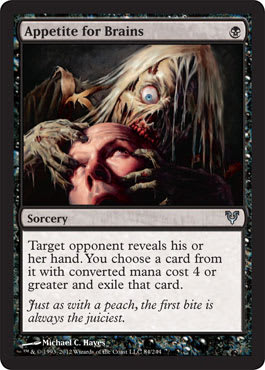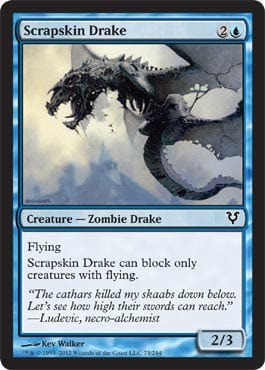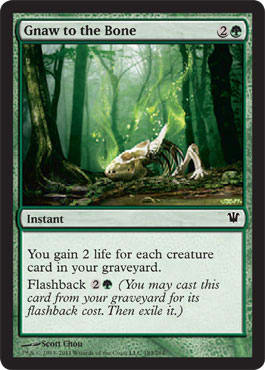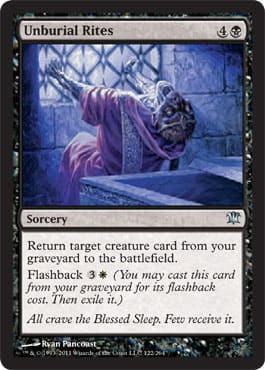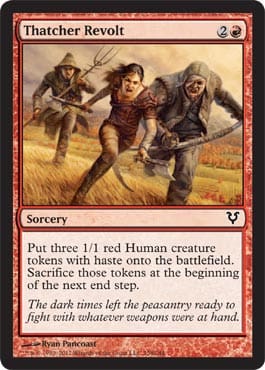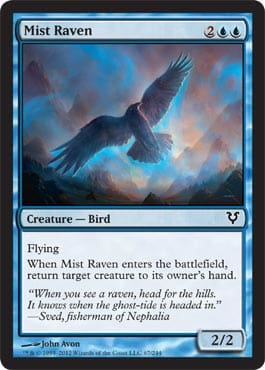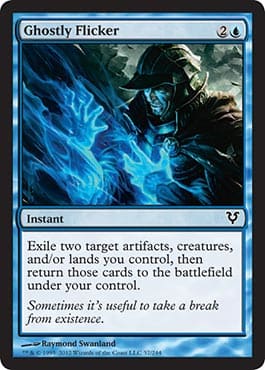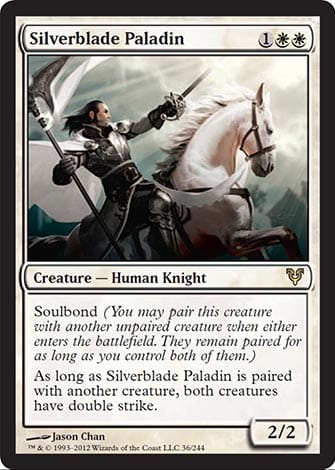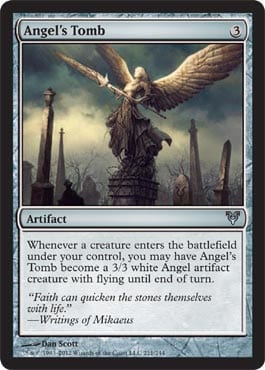Now that we’re done drafting Innistrad, we can move on to judging sets to be “certainly no Innistrad” or “the best set since Innistrad.” While that set was still the new hot thing, I took the time to kindly remind people that (due to regression to the mean and several other complex-sounding phrases that I use with my nose skyward) the next Draft format wouldn’t be nearly as fun. On average, the next large set will be average.
Now we have Avacyn Restored. I played in the prerelease, and I’ve done a few Drafts. As I predicted all bummer-like, Avacyn Restored is entirely average. But let’s dive beneath the outer surface level of “pretty good” and “all right” and into the deep, dark core of mediocrity.
What have the sets in this block been about? Innistrad was about horror. Dark Ascension was about how great Innistrad was, so let’s make some more Innistrad. Avacyn Restored is about what exactly?
Dramatic line breaks to encourage person reflection.
Could more rhetorical questions heighten the anticipation before I give my opinions?
More line breaks for hot, introverted thought-gathering action.
Avacyn Restored seems to be about how this set isn’t Innistrad anymore, which, like, I can tell already because it’s called “Avacyn Restored” and not “Innistrad.” It tries to make an impact with the fact that there are a bunch of Humans and not many monsters, but this is kind of weak; most sets are fairly light on horror monsters since most sets aren’t about horror. Most sets have a lot of Humans, too.
Let’s look at the first pack Jon Finkel opens in his Pro Tour: Avacyn Restored video (at a tournament that is titularly titled to promote the set and posted on a web site dedicated to selling more packs of Magic cards). Put yourself in the shoes of a newer player who doesn’t know anything about Avacyn Restored. These shoes will be much nicer looking than the ones you’re actually wearing because this player probably hasn’t spent half his lifetime sinking his income into cards as we have. Based on these fifteen cards alone, what is this set about?
The pack has three cards with soulbond, so that certainly emphasizes how important that mechanic is to the set. There are a couple Angels, and one of them is common. There are a couple non-soulbond creatures with enters-the-battlefield abilities and a couple that do something when they die. There’s another creature that has an ability when other creatures enter the battlefield. Going based on rules text alone, if I saw these cards for the first time, I would conclude that the uniting theme of this set is creatures with abilities that occur on changing zones.
Despite the seeming snarkiness there, I’m not sure what other uniting mechanical theme players are supposed to pick up on in our example. Sure, there are a couple Angels in the pack, so the player might get that Angels are important, but only a few cards specifically care about Angels, and Angels are still only doing angely things (flying, gaining life, making dudes, being awesome in Limited) rather than some change in their variety and role that would point toward it being an Angel set. When making a set about [thing], that thing can’t just be printed more often than it usually is. It has to be in colors it isn’t in usually, and it has to be used in some different way. Going back to Innistrad, blue doesn’t usually get huge recursive Zombies, and red isn’t the most obvious choice for Vampires that grow bigger the more they hit one’s opponent.
One potential solution to this could have occurred during block design. In order for white to have its breathtaking Angel-filled comeback in act three, it having fewer cards during Dark Ascension only to be one third of Avacyn Restored (similar to Torment/Judgment but in reverse and centered around one color rather than three) would have really heightened the impact.
They tried to do a similar trick without screwing up color balance by making white the only non-monster color in the first two sets and then making black the only non-Human color in the last set, but it’s just not as strong this way. There are still Zombies and Vampires outside of black, and there were already Humans outside of white in the first two sets. I’m sure the designers felt how nonwhite the horror sets wanted to be and how white Avacyn Restored wanted to be; I only wish they had given into that. If the color pie of your set points one way or another, don’t try to forcibly resist it.
The plot of the set can provide some guidance here: the Humans are the protagonists of Innistrad block, according to Mark Rosewater, and Avacyn Restored is when they finally get to turn the tables on the gruesome monsters that are more likely to eat the table than expect it to be turned. The issue I have is that such a theme is not very intrinsically interesting. I hate to tell this to my fellow humans, but humans banding together just can’t carry a set by itself. Monsters attacking, while commonly seen in media, isn’t something I come across in my everyday life. Humans working together, though? That happens when I order a Big Mac. Humans on Magic cards, being by far the most-often-depicted race, are basically a blank at this point. Human is the creature type used when we aren’t supposed to think about the creature type. It is to Magic set design as “he said” is to written dialogue. It is vital, necessary, useful, and often underused, but we’re not there to see a bunch of emphasis put on it.
As a passionate member of the Anti-Vorthos Coalition, though, an uninteresting-seeming, flavor-based theme wouldn’t bother me in the slightest if it played spectacularly. I don’t think Avacyn Restored does.
Before going into the actual playing-Magic part of analyzing a set: The purest and most direct way to rate how a set plays is Limited. While Constructed formats have to deal with metagames and oppressive cards and decks from previous sets, Limited is a way to look at a set in an entirely self-contained way. There’s no advanced work that has to go into designing representative decks or finding reasons to play new cards; players have to play a format that’s been carefully designed by R&D and (in the case of large sets) play exclusively with those cards, looking at every card printed. Even single-set constructed, while often a lot of fun (especially Innistrad), only uses a fairly small percentage of the cards designed for the set. Limited, by incentivizing the use of every card in the set, lends itself better to holistic design analysis.
It also better represents the way thoooose people play Magic.
It’s also way cooler.
For me, a good Draft format starts with interesting archetypes. A true archetype, as I think of it, is distinct from the usual Draft strategy of taking the best cards in two colors by having some plan beyond “cast good creatures and removal” that results in prioritizing cards differently than other players in that color. While the bright-line between a normal, two-colored Draft deck and a true archetype is certainly blurry, we all know cool archetypes when we see them; they’re the ones that, after the Draft, make us giggle excitedly at all the cool plays we’re going to make and show the deck to everyone around for reasons other than “I got so many good cards.”
Innistrad had all kinds of fun archetypes. While most of them were in some way related to self-mill and flashback (from five-colored flashback with Dark Ascension to U/R Burning Vengeance, G/U/b Spider Spawning, and even the occasional Unburial Rites–based reanimator deck), there was also a sometimes-terrifying, blue-based mill strategy with Curse of the Bloody Tome, R/G Werewolves with thirteenth-pick Moonmists, lightning-fast B/R aggro, and that stupid Invisible Stalker deck that is just unbeatable and ugh why do I always get paired against it and WHY DID THEY PRINT THAT CARD. (Hey, Innistrad had its issues, so don’t think I’m mythologizing it as perfect already.)
Where there will probably be a lot of disagreement will be as to where an archetype ends and just taking good cards begins. Was G/W with Travel Preparations an archetype or just another creature deck with 2-drops and removal? It’s definitely borderline.
There’s an obvious retort to saying that Avacyn Restored has no archetype comparable to Spider Spawning: “Aha!”, you might say, “but it took even pro players ages to figure out how to draft that deck! More archetypes will appear eventually!” I’m sure they will. It seems rather likely that someone will come up with a great strategy around an overlooked uncommon. However, this doesn’t change the feel of the Drafts . . . even compared to the early ones from Innistrad. That set had so many alternative synergistic ways to draft that it often felt like making up an archetype on the spot while going through it. It felt creative. Avacyn Restored gives me no such similar feeling, and discovering a new archetype here or there won’t change how every Innistrad Draft, from the beginning of the format, felt as though it revealed a new way to play it.
Avacyn Restored so far seems to have just one deck that I would describe as a true archetype in the synergistic mold (R/W Humans with Thatcher Revolt), and the format has a lot that are either borderline or worse. Green-based soulbond decks come close, but the only synergy-dependent cards in that are so much worse than the completely modular power- and toughness-boosting creatures as to be almost entirely irrelevant. Other colors have things to do that make synergy with themselves, but there’s not much in terms of cross-color synergies that make it feel like drafting a Constructed deck.
The best common in the set, Mist Raven, synergizes very well with practically every other card in blue. Is this an archetype? No, not really, unless you think that picking up multiple copies of the windmill-slam common and some cards in the same color to go with it is an unprecedented Draft strategy. What’s more, if you do draft this sort of deck, it’s incredibly frustrating for opponents to play against. As an example, the most recent Draft I did, I had quadruple Mist Raven plus a couple ways to blink it (including Deadeye Navigator).
Players might prefer having their creatures killed to having them countered, but it almost always feels worse to have a creature bounced if it was already bounced earlier. In one game, I played all four Mist Ravens before finding the Navigator to lock the game up permanently. Once I untapped with that combo, there were literally no answers he could have that could save him. That’s a rare, though, so it might be excusable . . . but playing Mist Raven on turn four, followed in consecutive turns by Peel from Reality, replaying Mist Raven, Ghostly Flicker, and let’s throw in an Into the Void at the end there.
For a game of Magic to be fun for a player, even a losing one, it has to feel that it’s progressing somewhere. When it comes down to replaying the same creature over and over (and the player can’t even kill the Raven due to both the lack of removal and how those synergistic pieces conveniently save it), it feels for the bounced player that he’s reliving the worst turns of the game repeatedly . . . Because he is.
The ways that blinking detracts from fun doesn’t end there, though. One of the advantages of cards with comes-into-play abilities is that, once they’re on the battlefield, they are (to use another Rosewater term) “virtual vanilla;” that is, they’re just power, toughness, and maybe a keyword. With rampant blink effects, though, virtual vanilla is no longer vanilla.
If I have
Especially with the cluttered board states that can occur in this format, it’s so daunting a challenge that I’d be tempted to just assume the person doesn’t have it just so I don’t have to work through all that crap. Other players might see this as making skill more important in Limited; I see a mechanic that changes a previously complexity-reducing tool (virtual vanilla creatures) into a way for board complexity to increase exponentially.
Next mechanic on the rundown: Soulbond! Soulbond is, as the competitors at the Pro Tour learned, way more powerful than people initially thought, and the card printed as a 2/2 for ![]()
![]() is a legitimate bomb. So, that’s cool, right? I’ve already written how much I like when mechanics are hard enough to evaluate that it takes people time to catch on.
is a legitimate bomb. So, that’s cool, right? I’ve already written how much I like when mechanics are hard enough to evaluate that it takes people time to catch on.
Soulbond certainly fits that, but it goes a bit too far; people just didn’t know what it did when they read it. I certainly didn’t before reading the reminder text several times, reading discussion about it, and seeing clarification about what wasn’t in the reminder text. But don’t take my word for it: Patrick Chapin wrote hundreds of words in praise of Silverblade Paladin, then more when he ranked it as the Number 4 white card that interested him . . . before saying he previously had thought creatures couldn’t be repaired once their initial pair-ee died, forcing him to reevaluate every card with Soulbond.
Will cards confuse players? Of course. Magic is a confusing game. Mechanics on higher rarities will certainly confuse newer players. Mechanics at common that are commonly misplayed by those players . . . well, that gets iffy, but it’s understandable from time to time (Book Burning, for example). Still, it should be avoided. But when the most common mechanic in a large set is misinterpreted by professional players who write about the game and is called out for unclear and confusing reminder text? That . . . is not good.
At my prerelease (the real one, not the one I wrote about), an opponent played a soulbond creature with another creature on the battlefield and passed. He was under the impression they were soulbonded by doing that—and if it was a more serious tournament than a prerelease, I definitely wouldn’t have let him soulbond them the next turn when they’re both already in play. Beyond that, the “choose not to soulbond my creature and soulbond it when I play a non-soulbond creature after it” was extremely unintuitive for many people.
And the Angel's Tomb thing? I’m scared to even tell people how that works. Or doesn’t work.
Overall, the set leaves me with the impression of being way too high-concept for its own good . . . and when I’m criticizing something for that, there’s definitely a problem. The theme of the set is extremely vague and hard to summarize (and “good guys winning” is definitely the least interesting part of anything horror-related), and the mechanics only fit with it on some very abstract, theoretical level, without giving the set a true mechanical identity to call its own. Ironically, the set that’s about Humans working together just doesn’t work together in a meaningful way.
Jesse Mason













